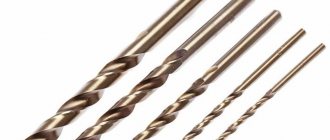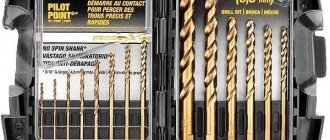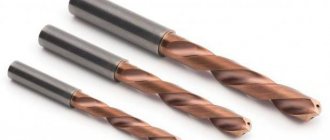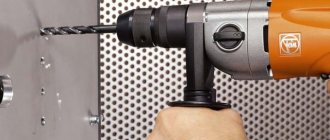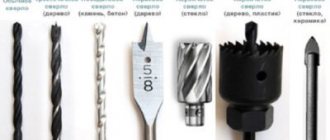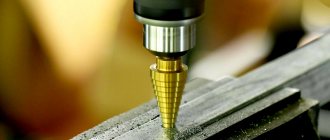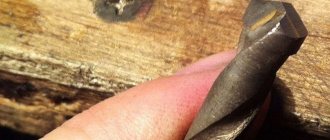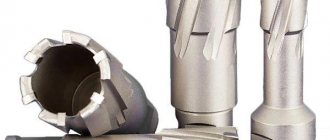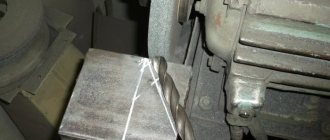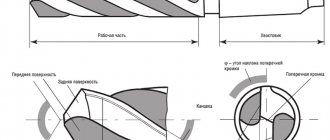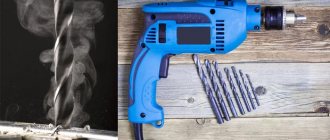Depending on the design, there are several types of drills. They come in different shapes - straight, curved, serifed, arched. One of the varieties is a center drill. It has an unusual shape, and can be used to process wood, metal, plastic, and metal-ceramics. But how exactly does a center drill differ from similar spare parts? What types of this instrument are found in practice? And what should you remember while drilling? This article will discuss these issues in detail.
Brief information
A center drill (CD) is a tool in the form of a double-sided drill, which is usually used in factory machines. It has a tail with a wide diameter, which allows you to securely fix the part in the drilling tool chuck. Centering drills have a central cutting part, which allows you to make holes at an angle of 90 relative to the plane of the workpiece. On the sides they have side tapered edges, which allow you to create large-diameter holes and recesses, make countersinks, and perform precise edge cleaning.
A centering drill for metal has the following advantages:
- High precision and quality of work. Centering drills for metal are securely fixed in a rotating chuck. And during work, the working tool does not slide on the canvas. This provides the structure with additional stability during rotation, which has a beneficial effect on the quality of drilling work.
- Increased shelf life. The worker can rotate the part so that the other side of the drill becomes the active cutting part. Therefore, such spare parts have an increased shelf life, and the worker needs to sharpen much less frequently.
- Universal application. CS is usually used for drilling metal, but it can also be used on other materials - it can be wood, stone, plastic. Surface preparation is usually not required.
Wood drills
Relatively small holes up to 12 mm in wood or wood composites (chipboard, MDF) can be drilled with a conventional metal twist drill. But holes that are subject to increased requirements for dimensional accuracy and surface cleanliness are made with drills specially designed for wood. They are made from tool or carbon steel and are not suitable for metal.
Twist drills.
Designed for drilling small and medium-sized holes. As already noted, you can use twist drills for metal instead, but the holes after them are of poorer quality.
Screw drills.
They have a sharp cutting edge and a screw-like shape. Thanks to the latter, chips are easily removed from the hole. These are high-quality drills that are used if you need to get a deep hole with a smooth wall.
Feather drills.
They are used to produce holes of relatively large diameters - from 10 to 25 mm or more. These are the simplest and most inexpensive drills, you can even make them yourself from a suitable plate and a round rod. But the quality of the holes after them is low - rough walls, not very accurate dimensions.
Crown.
The term “crown” means that this tool is made in the form of a hollow cylinder, on the edges of which there are teeth. The drilling is obtained in the form of a ring, from which the inner part is then removed. A crown is an indispensable tool if you need to get a large hole - up to 100 mm or more. In stores it is offered in the form of a set, which contains a mandrel, a centering drill with a shank and several crowns of different diameters.
Forsner drill.
This is a tool for making precise holes in wood (especially soft wood), chipboard, laminate, etc. It has a centering point and a sharp-edged scorer. Thanks to the latter, the hole is precise and smooth. If you need to get a blind hole with smooth walls and precise dimensions, a Forsner drill will do the job best.
Types of center drills
The main document that regulates the production of CS is GOST 14952-75. This standard lists all the key requirements for centering drills - type of metal, device dimensions, sharpening accuracy. Typically, the steel is made of high-speed steel - it provides high quality processing, does not require frequent sharpening, and easily cuts metal products. According to GOST, centering drills come in the following varieties:
- Category A. Such spare parts do not have a centering cone-fuse. The taper of the drill is 60 degrees. In practice, category A spare parts are rarely used due to the fact that most modern holes are made with a safety cone.
- Category B. Such spare parts have a protective centering cone that protects the spare part. The taper of the drill is 60 degrees. In practice, category B CBs are used most often, since the use of parts from this group significantly improves the strength of the hole.
- Category C. This group repeats category A in key parameters with the only exception - the taper in this case is not 60, but 75 degrees, which allows you to make larger, larger holes. Such digital systems are in demand in some industries (automotive industry, production of tools and equipment, radio electronics).
- Category R. In such CBs, the generatrices form an arc, which provides a number of drilling features. Using category R drills, you can produce highly accurate oval-shaped holes. In practice, the need for them rarely arises, however, there are certain areas where they are needed quite often (furniture manufacturing, mechanical engineering, processing of circuit boards for radio electronics, and others).
According to GOST, the diameter of a spare part can range from 0.5 to 10 centimeters, although in practice medium-sized parts are usually used. The diameter is determined by the dimensions of the main cutting part (whereas with other drills, the diameter is usually determined by the shank). Remember this when choosing a spare part - otherwise you will receive a larger spare part for drilling.
Selection principles
Construction markets and stores offer customers a huge selection of accessories for power tools and industrial equipment. However, before buying a tool, you need to familiarize yourself with its characteristics and study the manufacturers.
Center drill
Manufacturers
The quality and cost of drills is influenced by the reputation of the manufacturer. To choose the most reliable, high-quality tool, you can consult with other people. After analyzing construction forums and reviews left on trading platforms, the optimal manufacturer can be identified. This is Dormer. Buyers highlight the performance, accuracy, reliability, and durability of products from this company. The company produces drills from high-speed steel, carrying out additional heat treatment. To ensure that the equipment can withstand exposure to temperatures, the manufacturer adds cobalt to the composition. This component can be up to 5%.
Primary requirements
In addition to choosing a company that manufactures tools, when choosing equipment you should consider a number of requirements for drills:
- Professional models should be made only from high-speed steel. Additional components may include vanadium and cobalt.
- The surface of the steel should not be chipped, discolored, discolored, uneven, or cracked.
For equipment, deviations in size are allowed. For example, a model with a diameter of up to 0.8 mm may have an error of +/- 0.05 mm. Structures with a diameter of up to 5 mm may have deviations of +/- 0.15 mm.
Technical requirements for the CA
The center steel is made of high-speed steel, which provides a good level of cutting and is slightly dull during use. Spare parts of this type are sometimes made from steel with a high content of cobalt and vanadium. These additional elements provide additional strength. Therefore, using spare parts with the addition of cobalt and vanadium, you can drill even the most durable materials. For example, heavy-duty metal alloys, some types of stone or metal ceramics.
When manufacturing spare parts, slight deviations in diameter are allowed. However, they should not exceed 0.2 millimeters (for thin CS - no more than 0.05 millimeters). The surface of the drills should not have external defects - chips, large scratches, cracks, thermal burns. Discoloration in the groove area is allowed if it is caused by natural causes (due to frequent use of the drill). Periodically (1 or 2 times a year) it is necessary to test the CS for strength and compliance with GOST standards. A minimum of five drills from the kit are used for testing.
Tests are carried out in accordance with GOST standards, taking into account international requirements. Brief information about the tests:
- To check, a number of laboratory tests are carried out to evaluate the strength and physical condition of the spare part. The inspection must be carried out by an authorized person who has the appropriate clearance, education, and work experience.
- One of the main control methods is external inspection using a magnifying glass. It is necessary to check that the dimensions of the part have deviations of no more than 25%, and the angles - no more than 35%.
- During the test, a roughness check is performed according to the requirements listed in the state standard GOST 9378-93. During tests, you can focus on other standards.
- Perform a thermal stability test. During tests, a five percent emulsol solution or similar liquids should be used for cooling.
Don't forget to check for hardness, accuracy, length and other parameters. In case of unsatisfactory performance, it is recommended to abandon the use of CA. The presence of non-compliance with GOST standards may indicate that the tool has deteriorated and become unusable (strength has decreased, significant defects have appeared, temperature conditions have been disturbed). Avoid using such spare parts, as they reduce the accuracy of processing + there is a risk of injury in the workplace.
Quality control
Drills for making centering holes are professional tools. It is for this reason that they take full responsibility for monitoring their technical characteristics. The most important stage of quality control of centering equipment is checking its functionality. It is produced on special samples, which are made of steel 45 and on the HB scale have a hardness in the range of 187-207 units.
During the test, the performance of the tool that is being tested is compared with how a sample behaves under exactly the same conditions, the accuracy and rigidity parameters of which are precisely known.
After testing in metal processing, the center drill should not have any chipping areas on its cutting part. People who have tested the tool evaluate whether it is suitable for further processing. The means used for such control are a magnifying glass (loupe) and a measuring device necessary to compare the parameters of the instrument being tested with the value indicated in the drawing. GOST 8.051−81 when checking geometric parameters allows for the following errors:
- For angular values, a deviation of 35% from the specified tolerance is permissible.
- For linear geometric parameters and the relative position of equipment surfaces, a deviation of 25% from the tolerance indicated in the drawing is permissible.
Recommendations for the use of measuring instruments, as well as the rules for conducting hardness tests, are specified in GOST 9013−59. Such drills are also checked for surface roughness. To do this, they are compared with a reference sample. The requirements for the roughness value are set out in GOST 9378−75.
When checking the centering tool, as well as during machining, a cooling lubricant must be used. It is a 5% aqueous emulsol solution. Scheduled tests, which are carried out on 5 (or more) instruments, are carried out with the following frequency:
- Once every three years, the average time to failure is checked.
- Twice a year a check is carried out to ensure trouble-free operation.
Factory and home use of CA
Centering drills are in demand in many branches of human activity. They are used in factories involved in such areas as mechanical engineering, the production of high-precision equipment and tools, and furniture manufacturing. They are installed in private workshops, on the territory of workshops of small enterprises, and at service stations. The use of CS allows you to obtain an accurate perpendicular hole without bevels, with the help of which parts of complex structures will be fastened.
In addition, drills are often used by ordinary people in everyday life when they want to do some simple work. For example, with the help of such a tool it is easy to make a hole in damaged furniture, which can later be used to repair the product. Another example: CA can be used for drilling printed circuit boards - the drill will enter this surface exactly at an angle of 90 degrees, which will ensure high quality and precision processing. In everyday life, compact small drills are usually used, and the drill must be compatible with them (check this detail with the store salesperson).
Use at home
Many craftsmen have found use for centering drills at home . They are very popular among radio amateurs who often have to drill holes in small-diameter printed circuit boards.
Due to its high rigidity, this tool is preferable to a conventional tool for making small-diameter holes in such situations.
At home, centering drills with a diameter of 0.5−0.8 millimeters are used. This is explained by the fact that a tool with a small-diameter cutting part solves most household problems more effectively.
Using a centering tool, they drill out screws and screws that cannot be unscrewed with a regular screwdriver. But with the help of a centering tool, the heads of such recalcitrant elements are simply drilled out and then easily unscrewed. The easiest way to solve the problem is if you need to drill out the head of a screw or screw, on which the slots are intended for Phillips screwdrivers. But if the slots on the head are intended for a straight screwdriver, then you first need to mark it in order to indicate the specific place where the drill will enter.
Additional requirements according to GOST for CA
Don't forget about the GOST rules:
- It is recommended to store tools in boxes or insulated boxes. There are no requirements for temperature, light, or humidity, since tool steel is a durable and chemically inert material. The only point is to minimize the contact of the spare part with water, as this will lead to corrosion (water may begin to react with iron, which will lead to rust).
- Parts can be transported by any transport of the choice of the owner of the spare parts - water, air, road, rail. For transportation, spare parts should be packed in boxes or insulated packaging that will protect the spare parts from contact with water. There are no requirements regarding the purchase/sale of parts, with the exception of labeling - it must be applied to each package of the product, the information must be reliable. Do the sale of goods in accordance with current Russian legislation.
Dimensions and Accessions
I choose the drill size based on the size of the screw or screw whose head needs to be drilled out. The diameter of the centering drill shank should be equal to or slightly larger than the diameter of the “body” of the screw or screw (Fig. 2). The end of the drill is placed in the center of the screw head and drilled until the tapered part of the drill reaches the “body”. In this case, the screw head breaks off and begins to rotate along with the drill. It is at this moment that you need to stop the feed and stop the drill. From my own experience, I can say that further drilling is usually not required - the screw connection is more or less easily disassembled. Screw connections with “countersunk” and “semi-countersunk” heads are drilled in a similar way. You can also easily drill slotted screws for a flat-head screwdriver and rivets, but you must first tap them and then start drilling. Several times I had to use a center drill directly on the car, and in the most inconvenient and hard-to-reach places. I usually acted in the following sequence. Due to the impossibility of punching the center on the broken stud, I started drilling immediately with a centering drill. If necessary, deflecting the drill in one direction or another, I tried to direct it so that the center of the drill coincided as accurately as possible with the center of the stud. Then he continued drilling to the required depth with a regular twist drill and tried to unscrew the stud piece using a special tool - an extractor.
What does the color of the drill mean?
The color of the coating can roughly determine the characteristics of the drill. Regular quality drills have a gray paint characteristic of steel.
Black color indicates that the drill has been oxidized. That is, it is protected from corrosion and has improved heat dissipation properties.
A light golden tint indicates that the drill has undergone a tempering procedure, during which internal stresses are relieved.
The titanium nitride coating reveals itself with the bright shine of gold. Drills with it have an increased service life and low friction when drilling. Although they are more expensive, they more than justify their price with long-term operation.
Diamond coating can be recognized by its yellow color and powdery texture.
Recommendations for choosing a center drill
There are no universal centering drills. A centering drill must be selected based on a number of factors.
Let's list them:
- Firstly, you need to take into account the material with which you will be working, as well as the diameter and length of the working part, drill material, taper and type of centering hole.
- Secondly, if you plan to center the part before drilling it, the centering drill should be selected smaller in diameter than the size of the hole after final drilling. And vice versa, if you need to drill out a tightly stuck screw that cannot be removed with a screwdriver, then the drill must be selected with a diameter similar (or larger) to the screw that needs to be drilled.
- Many people use center drills to drill holes for threads. In this case, you need to select the diameter of the drill so that it is smaller than the diameter of the thread. Otherwise, it simply won’t be possible to cut it.
- It is also necessary to take into account the requirements for the roughness of the hole walls, since centering drills are available in two types.
Drill selection parameters according to GOST
Having looked at the GOST for a self-centering drill, it becomes obvious that you need to pay attention to a number of characteristics, such as:
- Appearance. It's simple: the instrument should never have scratches, dents or any externally noticeable mechanical defects.
- Accuracy. We look carefully at this indicator, because it determines what the tolerances for deviations in the diameter of the drilled holes will be. For example, if the diameter of the working area of the centering drill is less than 8 millimeters, then the deviation should not be higher than 0.05 millimeters.
- Hardness. If this parameter is deviated, the drill will not last long. If it is low, then the drill will not be resistant enough during operation, and if it is too high, then the drill will be fragile. The hardness should be between 63 and 66 HRC, according to the Rockwell hardness scale.
- Length. This parameter is responsible for the performance of the drill. It must be selected based on the length of the workpiece.
Popular manufacturers
Currently, retail chains offer customers centering drilling tools from domestic and foreign manufacturers. The cost of these products depends on the brand that produced the product. Domestic drills are of high quality at lower prices compared to foreign products.
Among domestic manufacturers, the products of Sekira LLC are the most popular among consumers. The company is located in the Sestroretsky district of the Leningrad region.
Centering drills are produced here in accordance with domestic GOST standards. Without re-sharpening, the tool from this manufacturer can perform about 120 drilling cycles.
As for products coming to our market from abroad, Dormer UK brand products receive special attention. Center drills are manufactured in the UK and comply with foreign technical standards. The steel alloy for this drilling tool contains the alloying component cobalt, so Dormer drills have high strength and excellent cutting characteristics. The tool is resistant to heat and has increased wear resistance.
The American brand DeWALT and the German brand Robert Bosch have good reviews on the quality of the centering tool. Among Asian manufacturers, the instrument of the South Korean brand YG-1 deserves trust. As for Chinese quality, you should be very careful when choosing a center drill from these manufacturers, since products that are visually attractive may turn out to be of low quality.

